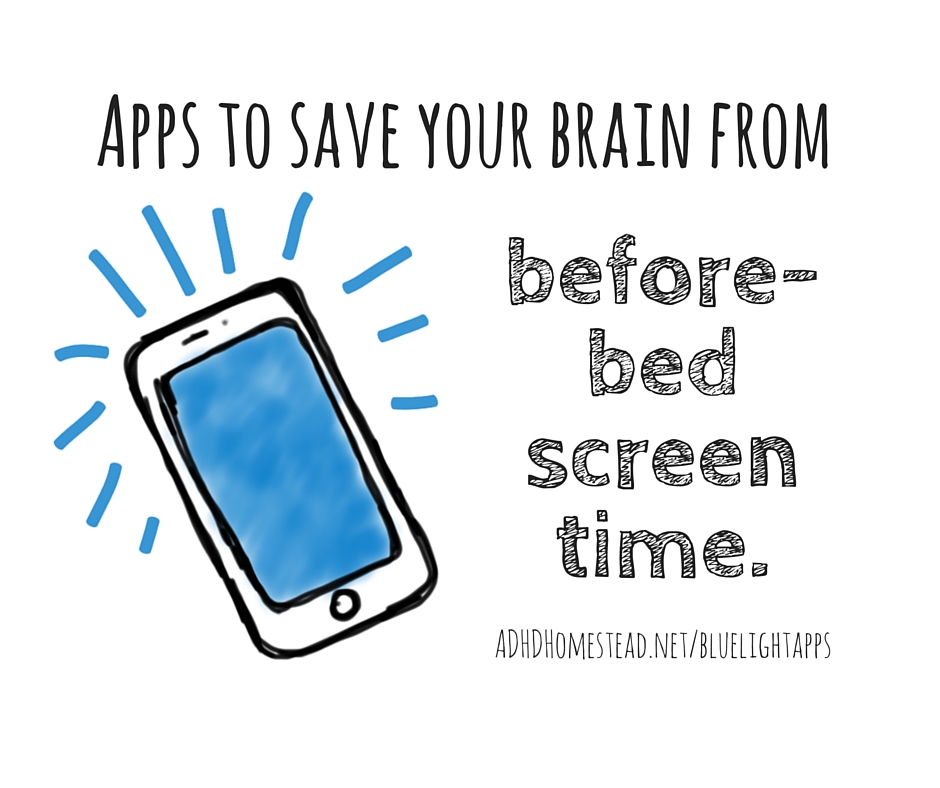When I first read Paul Bogard‘s The End of Night a couple years ago, hardly anyone was talking about the health effects of blue light. Since then, a number of articles and studies have made the rounds on the internet.
The bottom line: blue-rich light — like the kind emitted by computers, mobile devices, and many fluorescent and LED lights — isn’t good for us. After dark, and especially in the hour or two before bedtime, we should limit exposure to screens and other blue-rich lights.
Easier said than done. Certain behaviors often feel beyond our control. For those of us with ADHD, a hard-and-fast “no screens within an hour of bedtime” habit may be impossible.

Assume you’ll use screens at night, and reduce negative effects.
Knowing my willpower is a finite resource, I scrimp and save wherever possible. I know trying to put my phone and tablet down after 9:00 p.m. every day is a recipe for failure. Sometimes I need to work late to finish a writing project. Other times I get sucked into a mindless, fatigue-induced journey through my Facebook feed. That’s why I use apps to filter blue light out of my computer or mobile device’s display.
For my Windows computers, I use f.lux, which is available for all major operating systems. F.lux autodetects your location and adjusts your screen based on when the sun rises and sets. It works great out of the box and requires very little know-how beyond downloading and installing a program from the internet.
 You can further configure f.lux to fit your lifestyle by setting your bedtime and wake time. If you’d like to set your location manually, to someplace else — a friend living in Stockholm says this helps with the very long/very short days up there — you can do that, too.
You can further configure f.lux to fit your lifestyle by setting your bedtime and wake time. If you’d like to set your location manually, to someplace else — a friend living in Stockholm says this helps with the very long/very short days up there — you can do that, too.
Many mobile devices now offer built-in blue light filtering. iOS provides their Night Shift setting, which is also available on computers running MacOS. Many recent Android devices have a blue light filter in the toolbox settings. Amazon’s Fire Tablets include a feature called Blue Shade.
Some older Android devices don’t have built-in blue light filters. I like Twilight in those cases. Like the desktop version of f.lux, it works right out of the box and auto-adjusts based on sunrise and sunset.
You’re still responsible for going to bed.
Blue light filters aren’t a blank check to stare at a screen all night, but they may help prevent or correct sleep problems. Sometimes we succumb to screen suck, or we get stuck working late to meet a deadline. Screen tinting after dark may minimize long-term effects of these slip-ups.
One thing’s for sure: when it comes to maintaining our circadian rhythms, the ADHD’ers in our household need all the help we can get.
Do you struggle to part with screens at night? Have you tried these apps (or others)? If not, do you think it’s worth a shot?
This post was updated on October 23, 2018 to reflect current Android and iOS features.
Hey there! Are you enjoying The ADHD Homestead?
Here's the thing: I don't like ads. I don't want to sell your attention to an advertising service run by the world's biggest data mining company. I also value my integrity and my readers' trust above all, which means I accept very few sponsorships/partnerships.
So I'm asking for your support directly. For the cost of one cup of coffee, you can help keep this site unbiased and ad-free.
Below you will find two buttons. The first lets you join our crew of Patreon pals and pledge monthly support for my work. Patrons also have access to my Audioblogs podcast. The second takes you to a simple donation page to pledge one-time or recurring support for The ADHD Homestead, no frills, no strings. Do whichever feels best for you!

